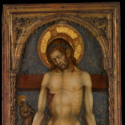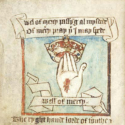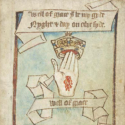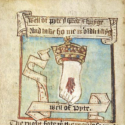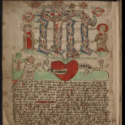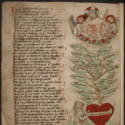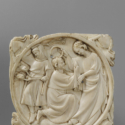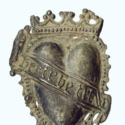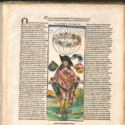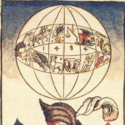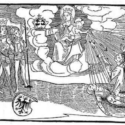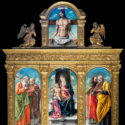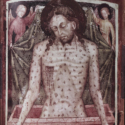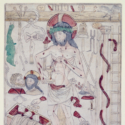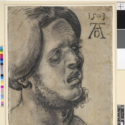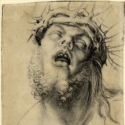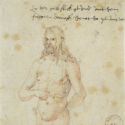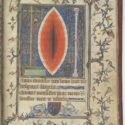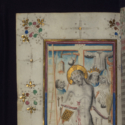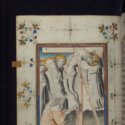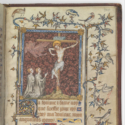‘Your body is full of wounds’: references, social contexts and uses of the wounds of Christ in Late Medieval Europe
Article DOI: https://dx.doi.org/10.15180/211503
Abstract
In this collaborative essay, the authors investigate the different ways in which representations of the wounds of Christ functioned in devotional practices as well as within a wider European context. The first section considers the wounds of Christ rendered as life-giving wells in Princeton MS Taylor 17, a fifteenth-century Middle English prayer book, focusing on their relationship to contemporary secular imagery as well as devotional literature about the heart. The second section focuses on the illustration on a Syphilisblätter, Dürer’s ‘Syphilitic Man’ (1496), and considers the visual referents relied on by the artist to communicate complex devotional ideas. This section also considers Dürer’s own relationship to philopassianism and positions this image within the artist’s oeuvre. The third section focuses on the Loftie Hours and the Hours of Bonne of Luxembourg, both produced for female patrons in the Later Medieval period. Through consideration of the patterns of wear and intervisual relationships with contemporary illustrations of vulvas, the potential of these manuscripts to express different gendered positions alongside pious and devotional practices is examined.
Keywords
arma Christi, Art History, Mediaeval Art, philopassianism, Renaissance Art, wounds of Christ
Introduction
https://dx.doi.org/10.15180/Found on altar pieces, on church furnishings, in private prayer books, scrolls and on jewellery, the bleeding, wounded body of Christ was omnipresent in Late Medieval European visual culture. The instruments of Christ’s torture and suffering, the arma Christi, were rendered in Medieval manuscripts, textiles and sculptures. Like the vir dolorum (man of sorrows), Christ displaying his battered and bruised body, often showing his bleeding palms and prodding the wound in his side, the representations of the arma Christi provided Medieval Christians with the means to contemplate and consider the events of the Passion and the suffering Christ endured for their sins.
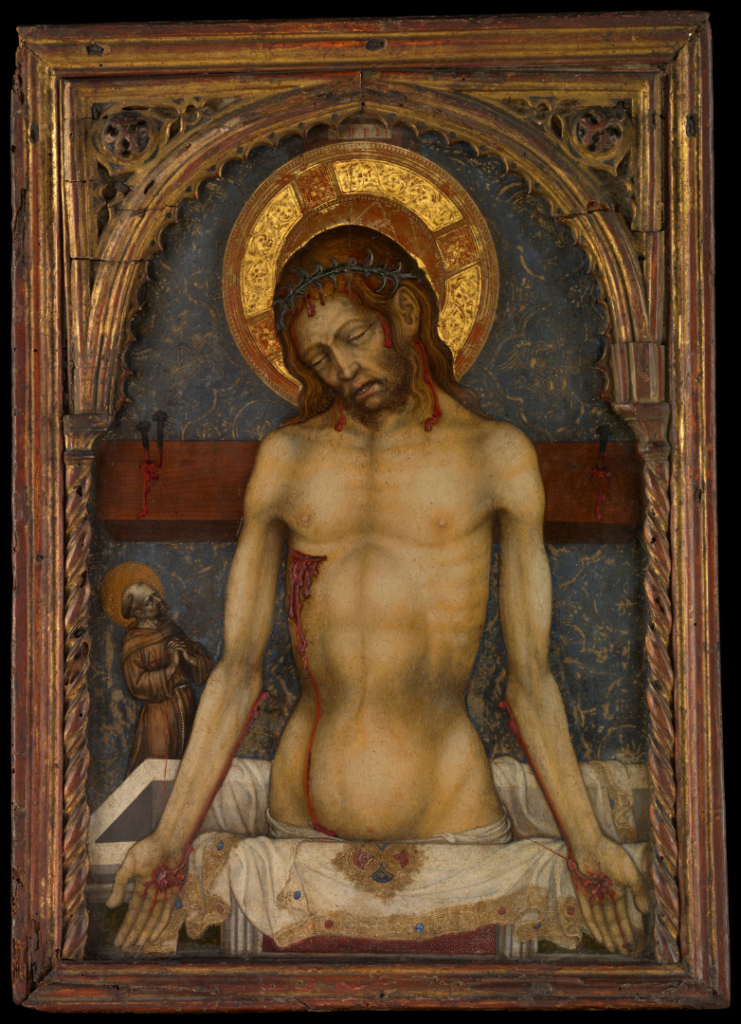
Among the physical objects rendered in the arma Christi was also the side wound, disembodied and removed from its original corporeal context (see Figures 2–6). The five wounds were prolific in Medieval visual culture and can be found in varied intellectual and physical contexts. The last twenty years has seen an increased attention on the possible meanings, intervisual and iconographical referents for the Medieval motif, and the contemporary reception and interpretations. These following three essays all reflect and respond to these shifting interests and ideas. The authors consider the wounds of Christ in different social and practical contexts and discuss how the receptions and uses of the motif changed to respond to the devotional needs of different and changing audiences, elite and lay, men and women. Through the multivalent image of the wounds, the Late Medieval viewer – as well as contemporary viewers of these images – can reach an expanded understanding of the Passion and its centrality to the social and religious lives of Late Medieval Christians.
Johanna Pollick considers a depiction of Christ’s wounded heart as a flowering ‘well of life’ included in a private devotional manuscript, discussing how the image was used in devotional practice and how the flowering heart image relates intervisually both to contemporary religious texts and images, and to popular, secular love imagery. Emily Poore writes about Dürer’s ‘Syphilitic Man’ and shows that this image, although often described as secular and strictly scientific, intentionally drew on the iconography of the man of sorrows to align the suffering of those with the Great Pox and other ailments to Christ’s sacrifice. Sophie Sexon discusses representations of the wounds in Books of Hours and their intervisual relationship to contemporary images of vulvas in different contexts, demonstrating that the vulva-wound motif allows for various genders to explore tactile relationship to Christ’s body creatively.
The three studies demonstrate the centrality of devotion to Christ’s wounds in this period, the broad geographical reach of this motif and the visual flexibility that allowed it to operate within different contexts: provoking and generating new meanings and interpretations. The authors focus on different aspects of representations of Christ’s wounds. Through this close analysis and consideration of the larger visual, material and textual contexts, as well as the social and physical environments in which these images were encountered, the essays highlight how the motif operated within distinct contexts that shaped possible audience responses. These three essays demonstrate the versatility of a motif capable of representing not only aspects of devotional religious practice, but also of inspiring reflection on one’s own place within society and what it means to be internal or external to the larger body politic by means of illness, gender or faith.
The flowering wound: Christ’s heart in Princeton University, MS Taylor 17
https://dx.doi.org/10.15180/211503/002Johanna Pollick
Princeton University, MS Taylor 17 is a small English illuminated devotional book, dating from c.1500. Though its owner is unknown, its small size – the folios measure approximately 12.1 x 9.1 cm – suggests that it was designed for the personal prayer and contemplation of an individual. Taylor 17 contains a variety of Middle English prayers including a verse prayer on the five wounds of Christ known as ‘Gracious Lord for Thy bitter passion’ (Boffey and Edwards, 2005, no.1011). Though the five wounds are not explicitly mentioned in the Gospel account of the Crucifixion, in the Later Middle Ages they became a key focus of devotion to Christ’s Passion, and they appeared throughout Europe in a range of artistic and literary formats and in numerous contexts. The cult of the wounds appears to have been particularly popular in England, and remained so even after the Reformation (Duffy, 1992, pp 238–48). Latin prayers to the wounds, often illustrated, were frequently included in books of hours, and devotions in English to the wounds were also abundant, with dedicated sermons, prose meditations and verse prayers, many of which incorporated images of the wounds, like the prayer that is my subject here.
Following a prefatory image of the five wounds arranged on a shield with a cross and chalice, Christ’s hands, feet and heart are depicted individually in five subsequent images, as a disembodied and bleeding body part (Figures 2–6).
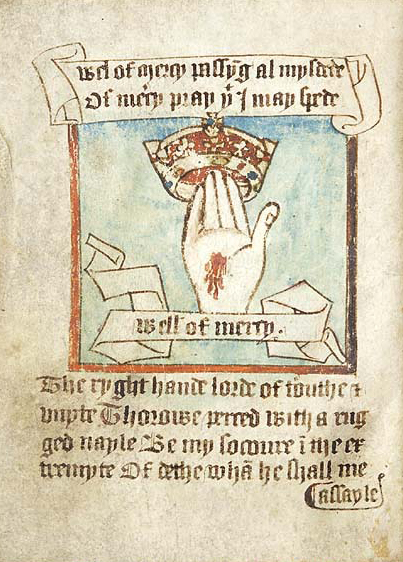
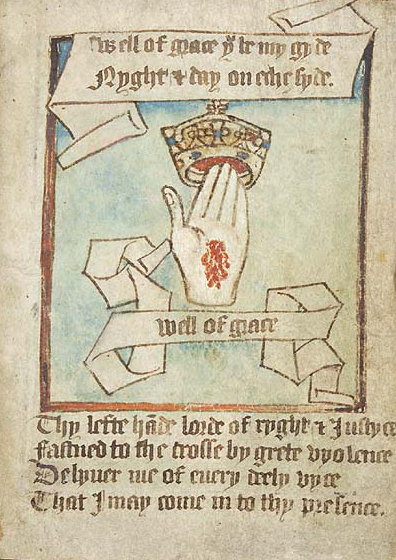
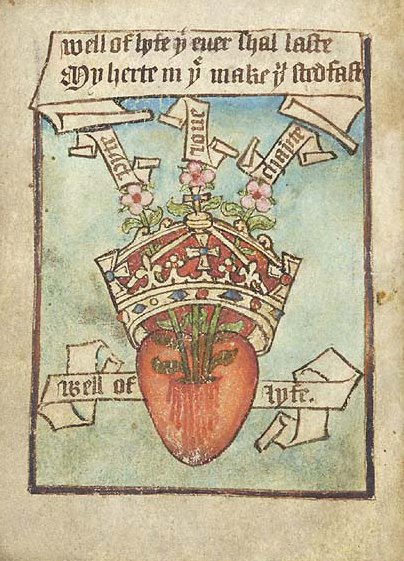
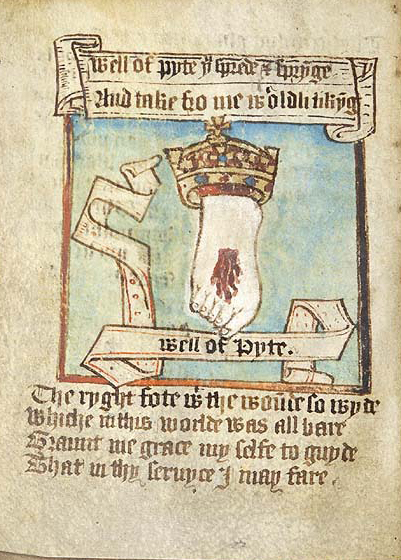

The wounds are topped with jewelled crowns, and accompanied by banderoles bearing the inscriptions ‘well of mercy’ (right hand), ‘well of grace’ (left hand), ‘well of lyfe’ (‘well of life’, the wounded heart), ‘well of pyte’ (‘well of pity’, right foot), and ‘well of conforte’ (‘well of comfort’, left foot), with accompanying prayer verses expanding on the properties of the wounds and their efficacy as a tool for protection from sin.[1] Through the identification of the wounds as ‘wells’, each wound is given its own distinct identity as an object of devotion, distancing the wounds from the moment of their infliction during Christ’s Passion. In Taylor 17, the wounds of Christ are transformed from signs of his agony and humiliation on the cross into five wells, plentifully flowing with blood as a source of the spiritual benefits of mercy, grace, life, pity and comfort. This analogy between a well and Christ’s wound, or the person of Christ more generally, was a common trope in Late Medieval English devotional texts,[2] but the pictorial and literary imagery of Taylor 17 is notable for its particularly detailed yet simultaneously narrowly focused rumination on the wounds as wells.
The most elaborate of the wound-as-well images of Taylor 17 refers to Christ’s side wound as the ‘well of life’, here depicted as a wounded heart (see Figure 4). It is the largest of the five images of the wounds, and is situated centrally within the text and image sequence. The large red heart floats within the frame, which encloses the image and is presented frontally, confronting the viewer. The pale blue background isolates the heart from any narrative, spatial or temporal specificity, lending it a timeless and eternal quality and obliging the reader to focus solely on the organ itself, removed from Christ’s body and displaying its large wound from which long trails of blood drip downwards. Three flowers emerge from the wound in the centre of the heart and protrude from the top of a large and elaborate bejewelled crown. Each flower is accompanied by a separate text scroll designating them, respectively, as ‘pyte’, ‘loue’ and ‘charyte’, symbolising the divine rewards Christ offers in return for veneration of this central bodily wound.
Of the five wounds of Christ depicted in this manuscript, only the heart is shown flowering, yet the presence or significance of the flowers is not expanded upon in the accompanying prayer. In uncovering the source and potential meanings of this iconography, therefore, it is necessary to look beyond the manuscript context to the wider literary and material cultures of Late Medieval England. To appreciate fully the range of meanings of this image of the flowering heart of Christ, I consider here the relationship between this motif and secular love imagery. Scholars such as Jeffrey Hamburger (1990; 1998) and Barbara Newman (2013) have observed the crossover of sacred and secular in Late Medieval images. Hamburger has elucidated the intermingling of sacred imagery and secular romance in manuscripts made and used by nuns in Late Medieval Germany. Allegorical images depicting Christ with the Bride of the Song of Songs as his loving spouse resonated with female audiences who would have been familiar with romance literature, recasting familiar stories in sacred imagery through which nuns could imagine themselves joined with Christ through a bond of love (Hamburger, 1998, p 51). Moreover, Newman’s concept of ‘Medieval crossover’ proposes that sacred and secular should not be treated as opposing categories; rather, although the sacred remains the default category, the two can ‘flow together like oil and water, layered but stubbornly distinct. At other times they merge like water and wine, an image dear to mystical writers’ (Newman, 2013, p 7). The image of the flowering heart and its accompanying prayer in Taylor 17 is an example of such a ‘crossover text’, in which the sacred and the secular are in continual dialogue. Through bringing this image into conversation with contemporary literature, both secular and sacred, and other forms of material culture such as secular love tokens, it is possible to reach an expanded understanding of this unusual iconography and its meanings in the prayer to the wounds of Christ in Taylor 17.
The image of the flowering wound in Taylor 17 can be connected with a long theological tradition of Christ’s wounds and blood as sweetly scented or flavoured. Ambrose (c.340–97), for example, in his Explanation of the Twelve Psalms, draws attention to the pleasant fragrance exuded by the wounds:
Christ’s wounds, however, were redolent with the fragrance of grace, not the stench of repentance. Hence it was not death’s decay that flowed from his wounds, as is the case with all other men, but it was the fountain of eternal life (McKinion, 2004, p 113: PL 14.1024c).
In imitation of the body of Christ, whose life and Passion was the prototype for all sainthood, saints’ relics could be sweetly scented as a marker of their holiness. Stories of saintly bodies resisting decay, sprouting scented flowers and foliage, and of trees proliferating at their graves, assert both the veracity and the continuing vigour of the relics; they are not dead but alive, and can heal or sustain life in the devout (Brown, 1981, p 76).
Analogies between flowers and Christ’s body and wounds also appear in Late Medieval English devotional works. In Richard Rolle’s Meditations on the Passion of the early fourteenth century, he refers to the wounded Christ thus:
Sweet Jesu, once again (a comparison): Your body is like a meadow full of scented flowers and health-giving herbs; in just this way, your body is full of wounds, sweetly aromatic for a devout soul and as health-giving as herbs for each sinful man (Allen, 1988, p 114).
By invoking the image of a flower-covered meadow, Rolle simultaneously obscures and magnifies the multitude of wounds covering Christ’s body inflicted by scourges, nails and other implements. Like the verse prayer to the heart in Taylor 17, Rolle’s text emphasises the sensory potential of the ‘scented’ and ‘sweetly aromatic’ wounds.
The fifteenth-century monk and poet John Lydgate also discerned a relationship between Christ’s wounds and flower imagery, exemplified by his poem As a Mydsomer Rose, in which he describes the wounds as ‘five Roosys’ (five roses) and Christ himself as ‘roose of the bloody feeld’ (rose of the bloody field), and ‘roose of Iericho, that greuh in Beedlem’ (rose of Jericho that grew in Bethlehem; McCracken and Sherwood, 1934, pp 780–85). Not only are the wounds and body of Christ roses themselves, for Lydgate, the five wounds also ‘prent in your hert a roose’.[3] This language of ‘imprinting’ a rose on the reader’s heart in memory of the five wounds reinforces the indelible effect of Christ’s Passion on the reader, and is suggestive both of the reader’s pious remembrance of the Passion, and of the everlasting life that it promises to the faithful.[4]
Two images from the late-fifteenth century manuscript known as the ‘Carthusian Miscellany’ (London, British Library, MS Additional 37049), an illustrated collection of religious works produced in a charterhouse in northern England, develop further the theme of the flowering heart, giving it both visual and textual form, and therefore invite comparison with the flowering heart of Taylor 17. In a variant of the Tree of Life image, the bleeding and crucified Christ is depicted on folio 36 verso, with the monogram of the Holy Name of Jesus wrapping around the branches of the tree.
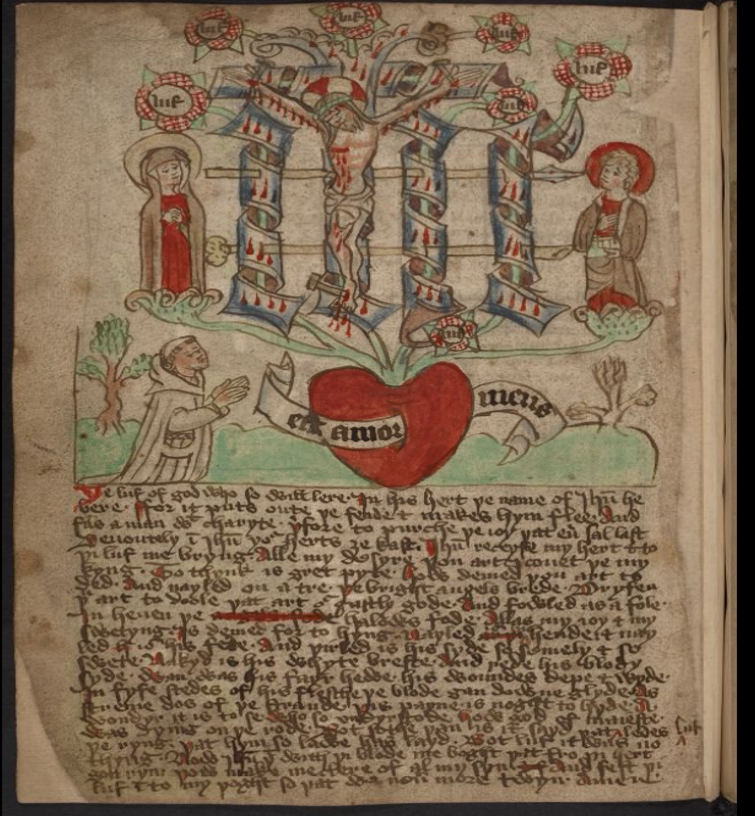
The Virgin and St John are depicted on either side of the cross emerging as ‘fruit’ from the tree, with other branches bearing red flowers inscribed with the word ‘luf’ (love). The entire tree emerges from a large red heart pierced with a scroll reading ‘est amor meus’, which taken with the Holy Name monogram gives the phrase ‘Jesus est amor meus’ (Jesus is my love). The presence of the kneeling Carthusian monk next to the heart, and the accompanying meditation addressed to Christ (Boffey and Edwards, 2005, no.3416), asking him ‘receyfe my hert and to þi luf me bryng’ (receive my heart and bring me to your love), implies that the heart is the monk’s own, from which a vision of the crucifixion, and the flowers of Christ’s love bloom, proving the efficacy of the monk’s intense prayer and devotion. A second image also depicts the heart blooming as a result of pious conduct; on folio 62 verso a kneeling Carthusian monk gazes up at a vision of Christ as the Man of Sorrows, supported by angels and revealing his side wound (see Figure 8). Next to the monk, a large red heart labelled ‘contemplacion’ sprouts a leafy plant bearing the virtues of monastic life, such as ‘dread’, ‘faith’ and ‘poverty’. Among these are ‘pity’, ‘love’ and ‘charity’, the same qualities depicted blooming from the heart in Taylor 17.
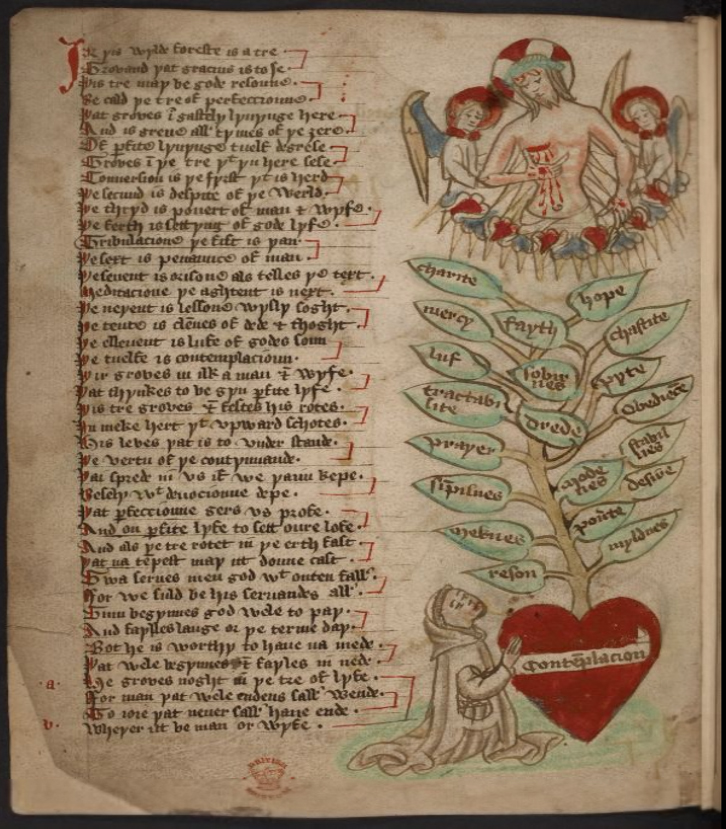
In both Taylor 17 and ‘The Carthusian Miscellany’, therefore, appropriate contemplation of Christ’s Passion is understood to propagate spiritual benefits for the devotee. Though Taylor 17 depicts the wounded and flowering heart of Christ, it could also encourage the viewer to contemplate the condition of their own heart, and could visually articulate for the reader their own internal spiritual growth through devotion to Christ’s heart and wounds. In the prayer accompanying the image of the flowering heart, Christ’s heart and the liquid it exudes are described as ‘helthfull fode’ (healthful food),[5] emphasising that they are a powerful source of nourishment to feed the reader’s own heart, in which pity, love and charity can then grow. Contemplating this image and devoutly reading the accompanying prayer, it is implied, can therefore lead to imitatio Christi, making one’s heart conform to Christ’s.
The iconography of Christ’s flowering heart also appears to have been informed by Late Medieval literary and pictorial imagery of courtly love, an examination of which yields insights into the multiple meanings of the flowering heart in the context of this illustrated prayer sequence. The heart had rich and varied meanings in Medieval art and literature, and could function as a metonym for the inner self, and for love, thought and emotion.[6] The gift of the heart was a common trope in both courtly love literature and imagery and in mystical writings. An ivory mirror cover made in Paris c.1300 depicts a kneeling lover offering his heart to a lady, who crowns him with a chaplet.
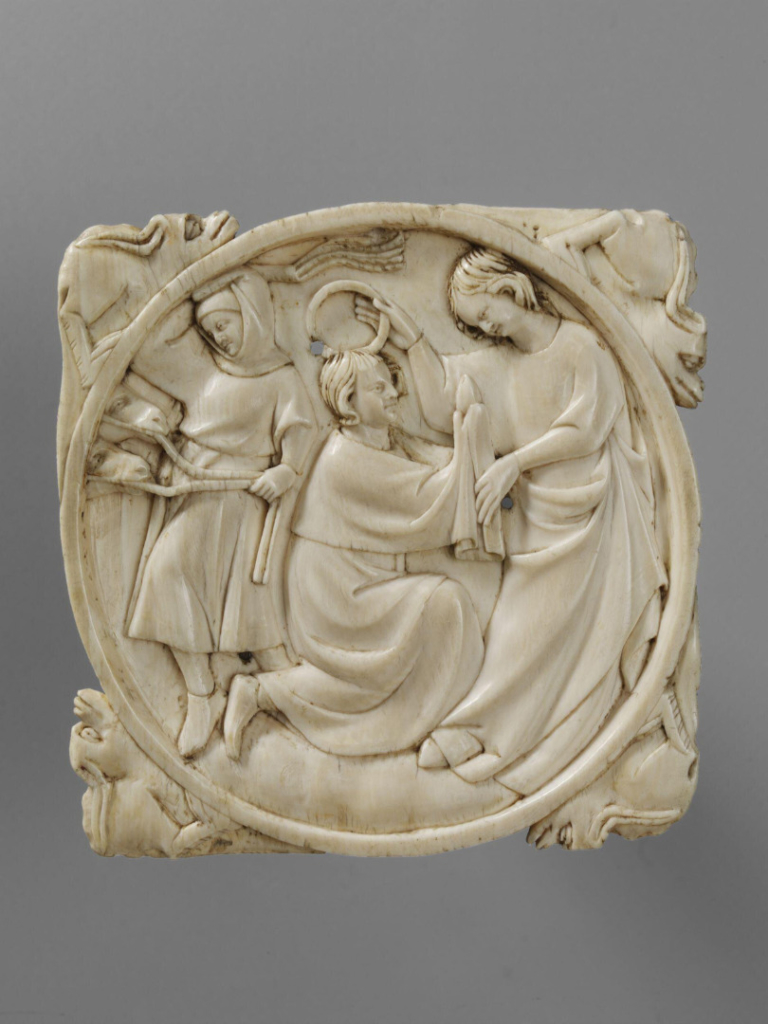
The composition of the scene may derive from the iconography of the Adoration of the Magi (Blamires, 1988, pp 20–21). As an object associated with the carnal and erotic gaze, the mirror cover is a suggestive site for the interplay of sacred and secular, and spiritual and carnal, love. As the mirror’s owner gazed into it, they became intimately physically involved with the imagery depicted; the close physical engagement that the mirror cover demands thus unites the spiritual aspects of its imagery with the sensual, bodily experience of the mirror’s user (Sand, 2014, pp 62–63). In a later example, the Petit Livre d’Amour of Pierre Sala, a small book of love poems in French approximately contemporary with Taylor 17, Sala is depicted in a full-page miniature giving the gift of his heart to a daisy or marguerite, symbolising his mistress Marguerite Builloud to whom the poems are addressed.[7] Instances of the gift of the heart, or an exchange of hearts with Christ, are also found in the Dialogues of the fourteenth-century mystic Catherine of Siena (Newman, 2013, pp 228–229; Webb, 2010, pp 136–138), and the writings of female monastic communities of thirteenth-century Germany and the Low Countries such as the Beguines and the community at Helfta, whose writings are marked by an intermingling of bridal mysticism with the tropes of courtly love (Newman, 1995; Hamburger, 1998, p 26). Though I do not suggest that these texts were sources for the prayer to the wounds in Taylor 17, they clearly demonstrate how the language and tropes of courtly love could inform and complicate religious writing and imagery to engage the reader-viewer and create shifting and multivalent layers of meaning. In each of these examples of the ‘gift of the heart’ in sacred and secular contexts, the act is construed as both loving and sacrificial; the lover’s heart torn from their chest is a visceral allegory for their anguish and desire, while also communicating the lover’s hope for spiritual and carnal union with their beloved.
It is also illuminating to compare the flowering heart of Taylor 17 with contemporary heart-shaped love token badges, which literalise the metaphorical gift of the heart depicted in the ivory mirror cover and Pierre Sala’s manuscript discussed above. Both manuscript and badge are highly portable objects, intended to be carried on the body and handled on an intimate scale; indeed, the flowering heart depicted in Taylor 17 is similar in size to many extant heart badges, and badges were sometimes sewn into manuscripts by their owners (Rudy, 2011, pp 15–19; Foster-Campbell, 2011).[8] The owner of Taylor 17 would likely have been familiar with, and may even have owned, a love token of this kind. Such badges appear to have been widespread; around 50 Medieval pewter heart-shaped badges have been recovered in archaeological excavations in London alone. Some of these badges depict flowers springing from the heart (Spencer, 1998, cat. no. 321e), and some, like the heart in Taylor 17, are crowned and accompanied by banderoles inscribed with text, such as a fifteenth-century example (Spencer, 1998, cat. no. 321d; Gilchrist, 2012, pp 109–111) depicting the heart crowned and emblazoned with a scroll inscribed with the motto ‘herte be trewe’ (heart be true).
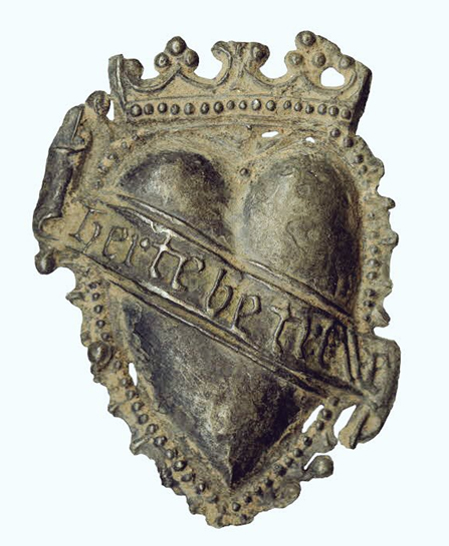
More luxurious items of jewellery depicting flowering hearts also survive, such as a gold and enamel brooch, made in England or France in the early fifteenth century (Lightbown, 1992, cat. no. 24), engraved with foliate decoration and the French legend ‘sanz de partir’ (without being parted).[9] For Late Medieval lovers, flowering heart badges espoused the ideals of fidelity and union in their inscriptions, and communicated desire for the growth and cultivation of romantic and sexual love.
In Taylor 17, the image of the flowering heart is invoked not as a gift from one lover to another as part of courtly ritual, or as a symbol of the pleasures to be gained from profane love. Instead, this prayer is concerned with avoiding sin and serving Christ, and the spiritual rewards of pity, love and charity that result from this ideal form of love. Yet the secular love imagery discussed above and the heart in Taylor 17 both foreground the theme of sacrificial love, of the lover giving themselves over to the one desired. The type of love encapsulated by the flowering heart in Taylor 17 necessarily involves sacrifice and suffering as a route to spiritual growth and renewal and, ultimately, to union with Christ. By accepting the gift of Christ’s heart, and freely offering their own in return, the reader-viewer could participate in an act of imitatio Christi. The text accompanying the image of the flowering heart reflects this in its plea that the devotee’s heart will be moved to follow Christ: ‘And that my herte may so enclyne. The for to serue as one of thyne.’[10] The flowering heart acts as a metonym for Christ’s sacrifice, neatly encapsulating the gruesome corporeal reality of the Passion and its ultimate significance as the source of eternal life for the devout. In Taylor 17, Christ offers up his heart to the viewer, who in turn sacrifices their own heart in order to serve and follow Christ, just as the courtly lover gives the gift of their own heart, either metaphorically or in the form of a heart-shaped token. The interplay of sacred and secular love, and physical and spiritual union, inherent in the flowering heart imbues the love of Christ with a romantic or erotic dimension, while also charging worldly, romantic love with divine significance.
As I have begun to show in this brief discussion, the image of the flowering heart and its accompanying prayer in Taylor 17 draws upon and interacts with a rich iconographic tradition of the flowering heart, both sacred and secular. It is a multi-layered devotional tool, which not only draws upon contemporary parallels made between Christ’s body and flowers, as in Rolle’s Meditations on the Passion and ‘The Carthusian Miscellany’, but also engages closely with the themes and material culture of courtly love to present the reader-viewer with multiple layers of meaning and signification, challenging them to contemplate the many dimensions of love that the image and text make present. Consideration of secular love imagery, such as that of the ‘gift of the heart’ and secular love tokens contemporary with Taylor 17, leads us to a broader appraisal of the intersections between images of secular and sacred love in the Late Middle Ages and reveals the different ways in which this image can be read as an illustration of the loving relationship between Christ and the reader-viewer.
The image of Christ’s flowering heart, pierced with its large central wound and blooming with the flowers of virtue prompts the reader-viewer also to consider their own heart, and the inner transformation that will take place as a result of dedicating their hearts to Christ by reading and viewing the texts and images of this prayer. The image of the flowering heart partially obscures the violence of the Passion and transforms an image of death and torment into one which promises spiritual nourishment and everlasting life, yet simultaneously emphasises the endless nature of Christ’s suffering, and the perpetuity of human sin which lies at the root of that suffering. Fundamentally, then, the flowering heart in Taylor 17 communicates the message which lies at the root of Christianity: the redemption of human sin and the promise of eternal life through Christ’s sacrificial love.
From sacred wounds to syphilis: the influence of the Man of Sorrows on Albrecht Dürer’s 'Syphilitic Man'
https://dx.doi.org/10.15180/211503/003Emily Poore
In 1495, a wretched new disease emerged among mercenary soldiers fighting in the armies of Charles VIII, King of France, on the battlegrounds of the First Italian Wars (1494–1498).[11] The first sign was a small, often painless, genital lesion that spread into a rash of pustules across the body. The sores subsided and then returned, often escalating into cavitating lesions that disfigured victims; its effects could be fatal. A Venetian physician, Alexandri Benedetto, compared their misery to the most infamous biblical disease: ‘The entire body is repulsive to look at, and the suffering is so great…that this sickness is even more horrifying than incurable leprosy…’ (Benedetto, 1497, in Quétel, 1990, p 10). Like the biblical accounts of lepers who suffered before them, victims of the epidemic became social outcasts (Quétel, 1990, p 23). Their putrefying wounds produced a ‘loathsome secretion making such a stink’ that it was feared as a source of contagion (Ulrich von Hutten, 1519, in Quétel, 1990, p 28).[12] Initially called the French disease (Mal Francese, Morbus Gallicus, Franzosenkrankheit) because of its early association with the soldiers of a French king, or the ‘Great Pox’ in vernacular English, it has been broadly accepted that the epidemic was a more virulent strain of the bacterial disease known in contemporary medicine as syphilis (Sudhoff, 1925, IX; Quétel, 1990, 3; Panofsky, 1961, p 3).[13]
In response to the outbreak, a multitude of public-health prints were published in major German printmaking centres. The subject of this paper is one example, a remarkable broadsheet titled Vaticinium in Epidemicam Scabiem.

Published on 1 August 1496, the Vaticinium featured text by Nuremberg city-physician Theodorus Ulsenius and a woodcut by renowned German artist Albrecht Dürer. Known as the ‘Syphilitic Man’, Dürer’s illustration is the earliest known European image depicting the symptoms of the Great Pox (Panofsky, 1961, p 1; Eisler, 2009, p 48).
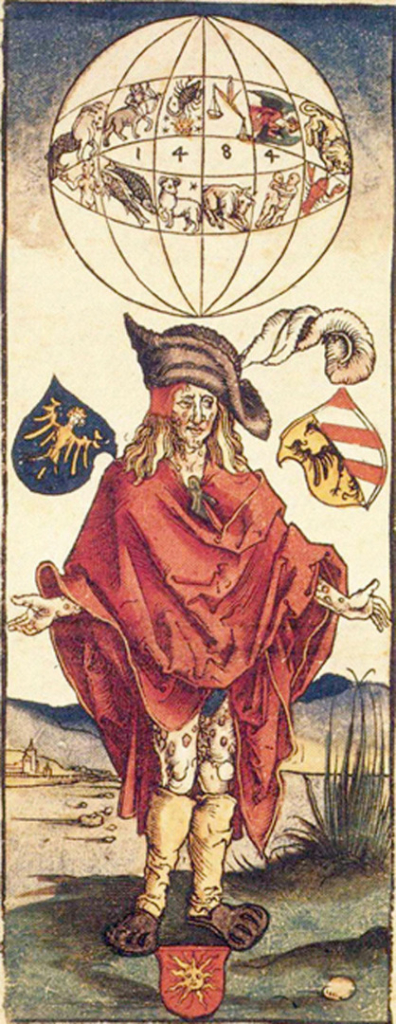
Ostensibly secular in nature, Dürer’s diagram has been described as ‘strictly scientific in terms of the criteria of its day, devoid of any religious or related sentiment’ and deserving ‘recognition for its uniquely advanced scientific and cultural objectivity’ (Eisler, 2009, p 59). While acknowledging that Dürer’s ‘Syphilitic Man’ contrasted the overtly Christian designs of other contemporaneous Syphilisblätter, this paper reassess earlier claims that Dürer’s woodcut is without references to religious imagery. It is argued that the pose of the ‘Syphilitic Man’ shares visual parallels with the ostentatio vulnerum, a gesture associated with images of Christ, particularly as the Man of Sorrows. This Christian symbolism is accompanied with solar iconography that refers to the Greco-Roman god Apollo who, as this paper will demonstrate, was interpreted in Christian texts such as the Ovide moralisé as Christ’s predecessor. In this intermingling of secular and religious imagery, the ‘Syphilitic Man’ shares similarities with the five holy wounds depicted in the Princeton MS Taylor 17, as described by Pollick in the text above. Furthermore, this paper contends that the ostentatio vulnerum was not intended as a ‘lurid parody’ (Panofsky, 1961, p 14), but rather sought to evoke Christian compassion for the victims of a terrifying and often fatal disease. Through considerations of early descriptions of the Great Pox and comparisons with ‘Man of Sorrows’ by Michele Giambono, Bartolomeo Vivarini, Antonio Bonvicino, Zanino di Pietro and a selection of Christomorphic portraits by Dürer, this paper seeks to rebalance the overtly secularised reading of the ‘Syphilitic Man’ by firmly embedding the print within its Late Medieval philopassianist context.
Understandably, the arrival of the Great Pox was the subject of great public concern. In response, a multitude of broadsheets and single-sheet prints known as Pestblätter (epidemic broadsides) or more specifically Syphilisblätter (syphilis broadsides) were published. They included discussions of the origins of the disease and provided apotropaic illustrations of holy figures and prayers that could be recited to grant their protection (Eisler, 2009, p 51; Schreiber and Heitz, 1918, tables 1–44). This magical function is shared by the amulets and charms showing Christ’s side wound that are discussed by Sexon in the text that follows below. An evocative example of a Syphilisblatt is Sebastian Brandt’s broadsheet titled De pestilentiali scorra sive mala de Franzos Eulogium (September 1496) that depicts the Great Pox as arrows that emanate from the infant Christ’s hand, punishing sinners with a rash of pox marks (see Figures 13, 14) (Sudhoff, 1925, p XXII).[14] So that these illustrations could stimulate daily devotions, they were pinned-up or glued with daubs of wax to walls in public and private spaces, or alternatively affixed into liturgical books, onto wood panels or into the lids of travelling boxes, where they were afforded more protection (Areford, 2010, pp 1–2, 4).
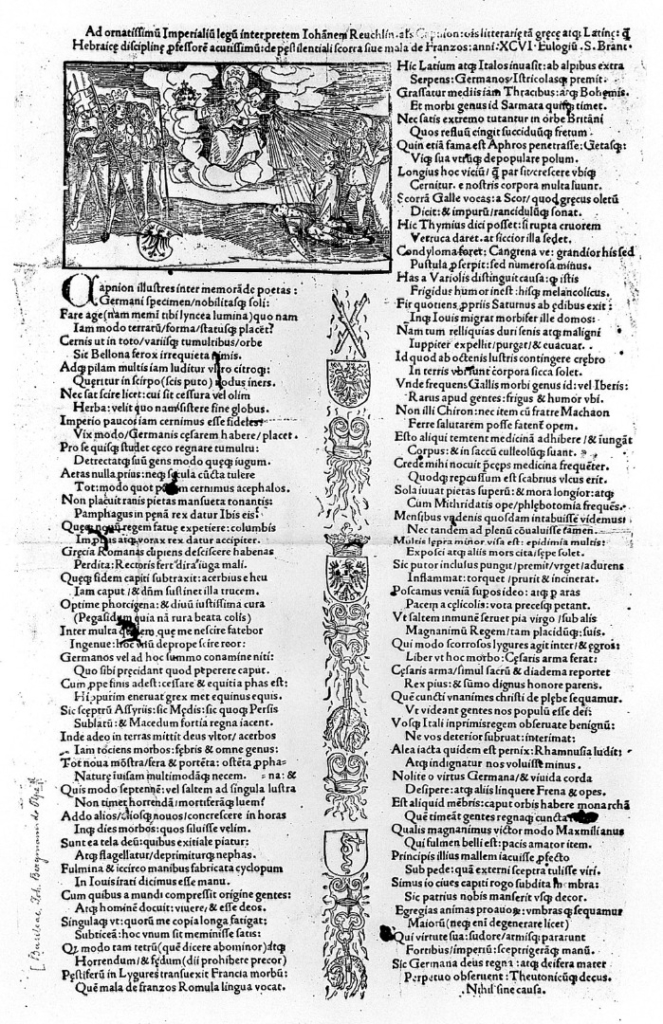
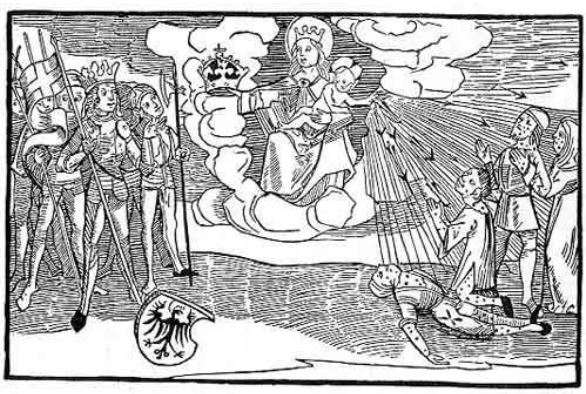
While the subject of this section – the remarkable Vaticinium in Epidemicam Scabiem by Theodorus Ulsenius – was related to these Syphilisblätter in terms of its mode of production and communicative function, its imagery contrasted the overtly Christian themes of its contemporaries. Rather than attributing the outbreak to God’s direct intervention, the epidemic was ascribed to astrological causes. Two columns of Latin verse by Ulsenius attribute the arrival of the ‘boils, ulcers and crusts’ of the Great Pox to the so-called Great Conjunction of 1484, an astrological event in which ‘no less than five planets, all except Venus and Luna, met in the Sign of Scorpion’ (Ulsenius quoted in Panofsky, 1961, pp 5 and 14). This conjunction was revealed to Ulsenius in a dream by Apollo – Greco-Roman god of truth, prophecy, healing and the Sun, among other attributes. Regrettably, Ulsenius woke before Apollo could divulge a cure. Additional references to Apollo were included in the decastitch at the bottom of the first edition of the Vaticinium. There, Ulsenius apologises for his doctor’s foray into poetry and presents an invocation to Apollo and the Muses. The second edition of the Syphilisblätter included a different decastitch, which returned to the overtly Christian references common to earlier Pestblätter. These ten verses recommended that the reader ‘composes one’s mind in hope and faith’ and to ‘drink of the water of Jordan’, a reference to 2 Kings 5: 13, where Naaman is cured of leprosy by dipping himself in the Jordan River (Ulsenius quoted in Panofsky, 1961, pp 5–6). For this second edition, Dürer’s image was not modified and so included no additional visual reference to the religious themes explored in the edited decastitch.
Ulsenius’s report was illustrated by Dürer’s woodcut of a woeful Landsknecht (mercenary soldier) afflicted by a grotesque pattern of sores. He is clad in a voluminous cloak, codpiece, slashed leather boots and a felt hat festooned with an ostrich plume. His clothing is typical of the then-familiar style of a northern foot soldier (Eisler, 2009, pp 53–56), albeit one lacking suede tights that Dürer presumably excluded so the soldier’s wounds were visible. The Landsknecht is surmounted by a celestial diagram of the Great Conjunction of 1484 and is flanked by the two shields of Nuremberg that emphasise Ulsenius’s authority as the official city-physician. Therefore to create his diagram of the cause and effect of the Great Pox, Dürer synthesised an assortment of familiar motifs – a celestial globe, heraldic symbols and a mercenary solider – to create an innovative zodiac/wound man that represented obscure, complex relationships in simple visual terms. The symptoms of the Great Pox, the identity of the people first affected and the influence of the macrocosmic universe on the microcosmic human body were expressed in legible and concrete form within a single coherent image.
Certainly, ‘Syphilitic Man’ lacks overt references to Christian iconography that are a feature of other Great Pox illustrations published after the Vaticinium, such as Brandt’s De pestilentia. Nevertheless, it is too simplistic to claim the print is without references to a Christian visual lexicon. Arguably, the Landsknecht’s attire shares parallels with another figure familiar to the owners and viewers of Pestblätter: Saint Roch. He too was depicted wearing a large hat, clad in a voluminous cloak (sometimes decorated with a shell in the mode of a pilgrim) and with or without hose. He was typically shown lifting his cloak or removing his boots to display a plague bubo on his upper thigh (Schiferl, 1983, p 208), performing a kind of imitatio ostentatio vulnerum.[15] Nevertheless, this article proposes that references to another holy figure – Christ himself – are more firmly embedded within the multivalent iconography of the ‘Syphilitic Man’ in two ways: through the inclusion of a solar motif and an Italianate, open-palmed gesture reminiscent of the ostentatio vulnerum.
Given that Ulsenius identified his dream of Apollo as the source of his text for the Vaticinium, the inclusion of a solar icon at the bottoms of the woodcut was likely intended to symbolise him (Panofsky, 1961, p 13). The text included below the Sun supports this interpretation: ‘Insigni Archyatrie studio Sacrum’ (Sacred to the Noble Study of Fundamental Medicine) (Panofsky, 1961, p 13). Nevertheless, the Christian references implicit in this motif cannot be ignored. During the period of the print’s production, a figurative relationship was believed to have existed between Christ and Apollo, who was seen as a prefiguration of the Messiah; this view was developed in the Ovide moralisé and other texts (Fumo, 2010, p 79). As Mary Barnard has explained, their relationship was ‘based chiefly on Apollo’s ancient roles as sun-god, the god of healing, and the philosopher-god, whose identifying trait is wisdom. All three roles bear easily identifiable parallels with Christ in his Messianic mission’ (1987, p 65). Through these associations, the ancient trope of Apollo medicus – Apollo the healer – was considered an allegorical forerunner of Christus medicus.[16]
Christ’s presence is more directly alluded to by the posture of the ‘Syphilitic Man’, who presents his hands and forearms to the viewer with a gesture reminiscent of the ostentatio vulnerum (Panofksy, 1961, p 14). Ostentatio vulnerum (‘display of the wounds’) refers to poses enacted by Christ to direct the viewer’s gaze to depictions of his bodily trauma. Although these gestures could feature in narrative scenes – for example the presentation of Christ’s side-wound to Saint Thomas – the atemporal atmosphere of Dürer’s print and the focus it directs to a single figure most closely resembles a Man of Sorrows. First appropriated within Latin-speaking contexts from Byzantine prototypes, the Man of Sorrows motif is argued to have either spread into western Europe from Tuscany or Venice or developed north and south of the Alps simultaneously, where it became ubiquitous from the fourteenth until the mid-seventeenth century (Barcham and Puglisi, 2011, pp 10–11; Jurkowlaniec, 2013, pp 51–52, 55). Essentially, the motif depicts Christ after his crucifixion, positioned within the viewer’s reach and accompanied by isolated references to the crucifixion narrative. Early examples show Christ gently crossing his arms against his body; in later versions he becomes more active, stands upright, and holds his palms to the viewer, points towards his side-wound or splays it apart with his fingers. Pictured in this manner, the Man of Sorrows exists in an atemporal state of living-death, forever locked into a perpetual passion.
Given the prevalence of the Man of Sorrows, it is difficult to ascertain precisely where Dürer first encountered the ostentatio vulnerum of our concern. Millard Miess noted that Man of Sorrows with their arms extended ‘full-length’ were ‘peculiar to Florence and to the third quarter of the [thirteenth] century’ (1979, p 124).[17] Decades later, similar gestures were adopted in Venice (Barcham and Puglisi, 2011, p 44, 68) and Dürer may have encountered them in the Veneto, given that he returned from a trip to the region the year before he created ‘Syphilitic Man’.[18] A notable Venetian proponent of the open-palmed gesture was Michele Giambono; his ‘Man of Sorrows’ (c.1430) emphasises Christ’s perpetual suffering by exaggerating the physical qualities of Christ’s blood (see Figure 1).[19] Thick sanguineous streams – sculpted in gesso – drip from his wounds, elbows and a trio of nails embedded in the cross behind him. Giambono’s tactile rendering of actively flowing blood suggests Christ has recently been removed from his crucifix, thereby conveying a paradoxical sense of immediacy paired with ongoing suffering. A figure of Saint Francis kneels to Christ’s right, directly receiving the stigmata and presenting Christ’s suffering as an ideal to be emulated through the practice of imitatio Christi.
Open-palmed Man of Sorrows gained greater influence in Venice when included in altarpieces, such as in Bartolomeo Vivarini’s Cappella Bernardo Altarpiece (1487), in the Basilica di Santa Maria Gloriosa dei Frari – one of the Venice’s most prominent churches.[20]
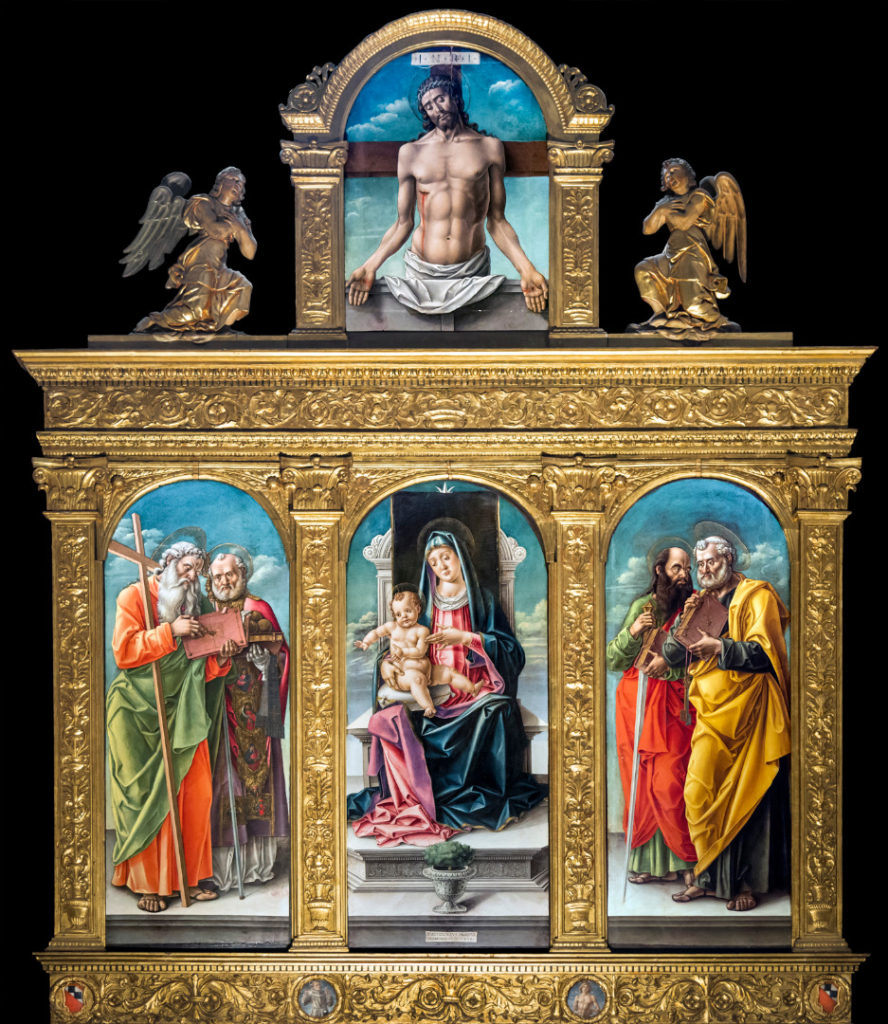
Of Vivarini’s contributions, the painting in the Bob Jones University Collection offers the closest match to the gesture of the ‘Syphilitic Man’.
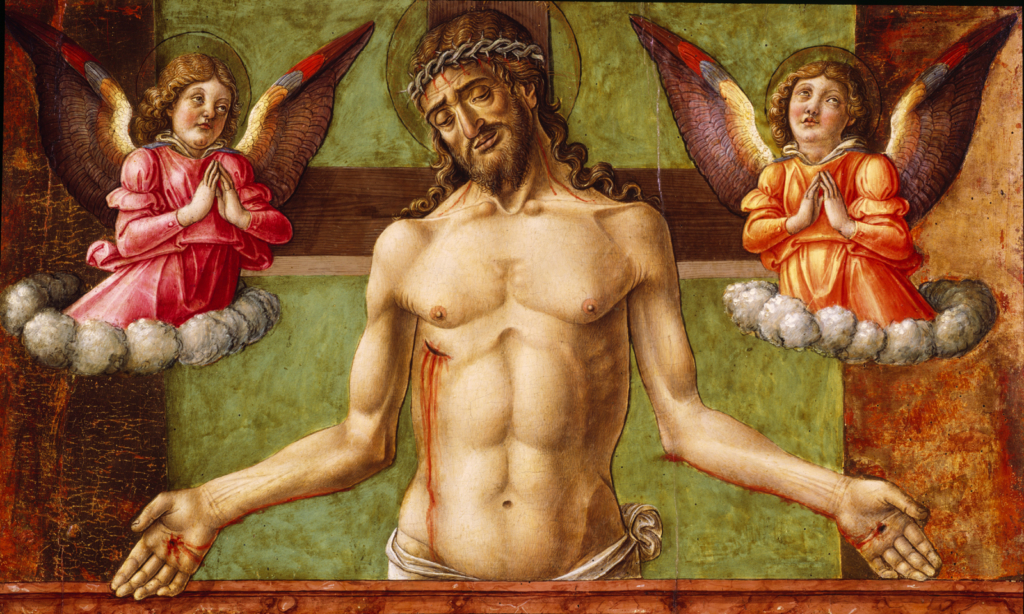
This panel, also believed to have been the central pinnacle of an altarpiece (Barcham and Puglisi, 2011, p 76), references the pose in Giambono’s painting, with a subtle difference. A fatigued Christ rests the tips of his fingers on the rim of his tomb, aligning his fingers with his hips and almost replicating the gesture of the ‘Syphilitic Man’. In subsequent decades, half-length Man of Sorrows were supplemented in Venice by a new, full-length, standing style. Early fifteenth-century examples showing the gesture of interest include a life-size wooden sculpture by Antonio Bonvicino, currently displayed in a supine position at San Carlo Borromeo Church, Mestre and a remarkably similar painting by Zanino di Pietro at the Galleria Gilberto, Zabert, Turin (Schulz, 2004, p 309).[21] However, in the Man of Sorrows discussed so far, signs of physical suffering are primarily focused on Christ’s scalp, and the five holy wounds; the surface of Christ’s skin remains relatively unscathed.
A lesser-known fresco located at the San Francesco Church, Lodi, some 250 km west of Venice, testifies to the visual parallels apparent between open-armed Man of Sorrows suffering from multiple wounds and the ‘Syphilitic Man’.
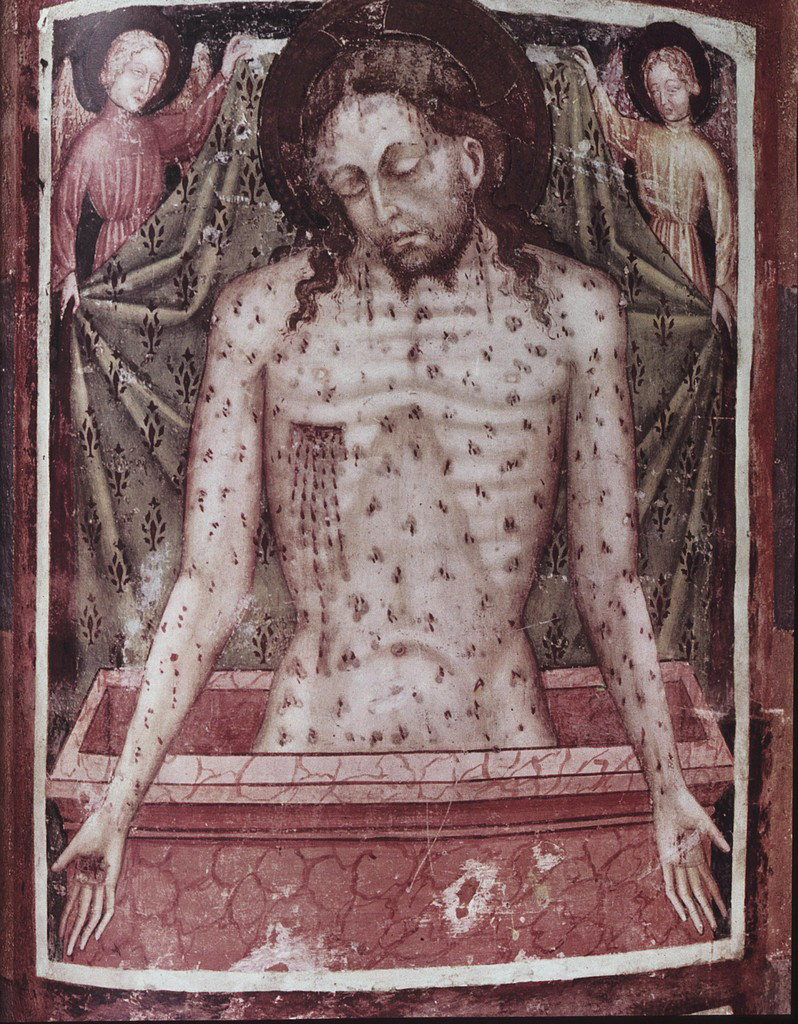
There, Christ stands with a gesture that is part display and part embrace, offering the striking pattern of wounds that mar his pale, emaciated flesh for contemplation. The macabre pattern of injuries is amplified by the patterned textile being held up in the background by sorrowing angels; even as our eyes wander about the background of the image our attention to returned again and again to Christ’s wounds. Humbly compelling us to look upon his painstakingly articulated lesions and empathise with his suffering, this Man of Sorrows appears – and functions – remarkably like the ‘Syphilitic Man’.
As the above discussion has shown, the open-palmed ostentatio vulnerum gesture became a tenacious feature of half- and full-length Man of Sorrows figures in Venice, where it is possible that Dürer was exposed to them. However, as Graźyna Jurkowlaniec has argued, ‘The main contribution of the artistic milieus situated north of the Alps consisted in depicting [the Man of Sorrows] as alive, active…and surrounded by the instruments of the Passion’ (2013, p 69). Indeed, open-eyed, dynamic ‘northern-style’ Man of Sorrows give the strongest impression of the living-death that characterises chronic diseases like the Great Pox. An elaborate example created in Ulm depicts Christ’s pale body assailed by a multitude of wounds and smears of blood inflicted by the numerous weapons that make up part of the elaborate arma Christi (Figure 18) that fills the background.[22]
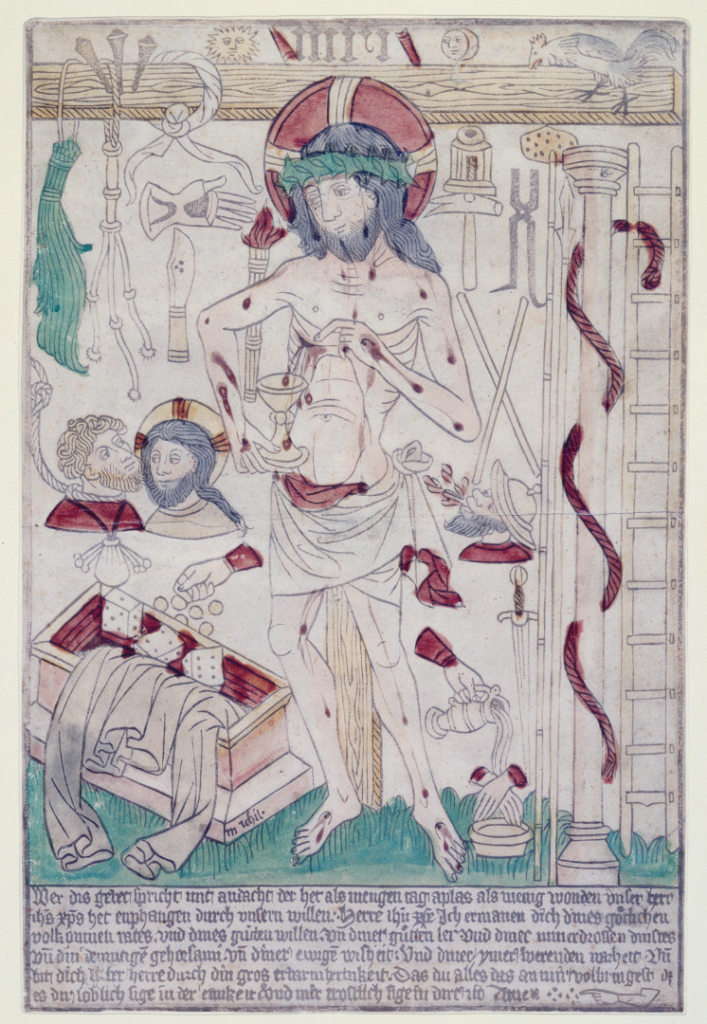
Enumeration of these wounds was important; an indulgence prayer for as many days as the number of wounds Christ suffered – around 5,500 by various medieval calculations – was included below the image (Parshall and Schoch, 2005, pp 181, 187, 248). While functioning as mnemonic devices to stimulate devotions, the arma Christi were often depicted as heraldic devices (Cooper and Denny-Brown, 2014, p 6), a quality shared by the heraldic shields of Nuremberg and Apollo that surround the ‘Syphilitic Man’. Furthermore, the Ulm Christ and the syphilitic both possess long, flowing locks that were common in Man of Sorrows images, but uncommon in contemporary prints of Landsknechte. While it is not claimed the Man of Sorrows images discussed here or in the preceding paragraph were definitely sources for Dürer’s ‘Syphilitic Man’, it is likely that he was influenced by these or other closely related examples, given their ubiquity and influence on Renaissance visual culture. By synthesising the Italianate pose of an open-palmed Man of Sorrows with the active, open-eyed characteristics of its northern equivalents, Dürer harnessed compelling images of perpetual, atemporal suffering into a potent symbol of a frightening, chronic disease.[23]
Dürer’s strategy in employing the Man of Sorrows as a model for the Syphilitic Man was complementary to the medico-religious doctrine Esther Cohen has termed ‘philopassianism’. According to philopassianists, physical and emotional pain were indivisibly linked to the suffering of Jesus and were viewed as a blessing, a means to empathise with Christ, and to metaphorically carry his cross in imitatio Christi (Cohen, 1995, p 59). This philosophy was cemented in medical settings by the frequent inclusion of representations of wounded Christs in hospital contexts. For example, at the Ospedale di Santa Maria Nuova, Florence, a sculpture of a Man of Sorrows (c.1424) was located in a lunette above the door leading into the cemetery, now destroyed.[24] Through this placement, the deaths of those interred within the cemetery were made comparable to Christ’s suffering and his side wound was presented as a passageway to restful salvation (Henderson, 2006, 114–15), much like the wounds of the MS Taylor 17 that were likened to wells flowing with mercy, grace, life, pity and comfort in the discussion by Pollick above.[25] Likewise, the Isenheim Altarpiece (1512–1516) featuring paintings by Matthias Grünewald and sculptures by Nikolaus of Haguenau was created for inclusion in a hospital complex that treated victims of Saint Anthony’s Fire (Hayum, 1977, pp 501–17; also Hayum, 1989). Christ’s putrid, boil-ridden flesh and twisted limbs recall the symptoms of that disease, giving visual expression to patients’ shared experience of suffering.
Evidence that a victim of the Great Pox perceived his condition through a philopassianist lens was provided by Orvietan canon Tommaso di Silvestro, who was the earliest person without medical training to record a description of its symptoms (Arrizabalaga et al, 1997, p 27). Silvestro’s account was deeply personal; he also had the Great Pox. In April, 1498 – two years after the Vaticinium was published – he lamented that:
all my head become covered with blemishes…and I became covered with boils, all over my front and back adeo [so far/to such an extent] that Corpus Christi [emphasis my own], I received treatment and medicine and blood-letting, and then they anointed me for the pains and for the boils that I had…I was washed with a bath of wine and many herbs, such as amaro, rue, mint, trasmerino, sage and other herbs (Diario di Ser Tommaso di Silvestro quoted in Arrizabalaga et al, 1997, p 26).
While Silvestro did not indicate whether or not he made a full recovery, he continued to write his text for another 15 years and did not mention his symptoms again (Arrizabalaga et al, 1997, p 27).
The potency of the body of Christ as an analogy for Silvestro’s blemishes, boils and his treatment by blood-letting, was probably influenced by the context in which he wrote his account. Since 1263, Orvieto has been the home of the Corporal of Bolsena, a liturgical cloth that was said to have been stained by blood that miraculously flowed from a host during a mass held by a priest who doubted the doctrine of transubstantiation. Tradition holds that this miracle inspired Pope Urban IV to inaugurate the Feast of Corpus Christi (Corpus Domini) in the following year.[26] The liturgical office of the Feast was written by influential theologian Saint Thomas Aquinas while he was living in Orvieto. According to legend, Christ expressed his approval for Aquinas’s liturgy by speaking to him through a crucifixus dolorosus located at the Church of San Domenico, saying, “You have written well of me, Thomas; what reward would you have?” Aquinas replied, “None other than Thyself, Lord.”[27] The miracle is commemorated by the words bene scripsisti de me Thoma that have been inscribed on the wooden base of the crucifix, added subsequent to the event (Raucher, 2015, pp 2–3). Like all examples of its type, the crucifixus dolorosus of San Domenico emphasised Christ’s supreme physical suffering. His emaciated body, stretched and strained over the cross, is painted with a dense pattern of wounds that issue blood in thin painted streams and thick ribbons onto the cross behind him. A deep wound in his side gapes open, spilling three-dimensional blood droplets that have been carved into the wood. Such an intense focus on this multitude of wounds finds parallels in Man of Sorrows of Lodi and the ‘Michil’ arma Christi in both style and affective intention (see Figures 17, 18). The tripart association of the miracle of the Corporal of Bolsena, the liturgical office by the renowned Thomas Aquinas and the brutally wounded and vigorously bleeding crucifixus dolorosus reveals how intertwined Christ’s corporeal suffering was (and continues to be) with the spiritual identity of Orvieto.[28] We can imagine that for Silvestro, the reverence of his city for the Corpus Christi would have inspired him to imagine his blemishes, boils and the blood-letting of his medical treatment as opportunity to practice imitatio Christi.
Signs that Dürer was himself a proponent of the doctrine of imitatio Christi are revealed by investigation of several of his Christomorphic self-portraits. Famously, his ‘Self-Portrait’ (1500) (see Figure 19) shares the frontal viewpoint and physiognomy of the Holy Face, and by showing him caressing the fur collar of his coat, mimics the gesture of benediction common in images of Christ and the saints (Panofsky, 1945, p 43; Koerner, 1993, pp 67–72 and 174).

Furthermore, three lesser-known drawings created subsequent to ‘Self-Portrait’ evidence Dürer’s ongoing interest in employing Christ’s image to convey his personal experience of illness. To create ‘Head of a Suffering Man’ and ‘Head of the Dead Christ’ (both 1503), Dürer harnessed the melancholic blackness of charcoal to depict two men suffering the consequences of bitter agony.

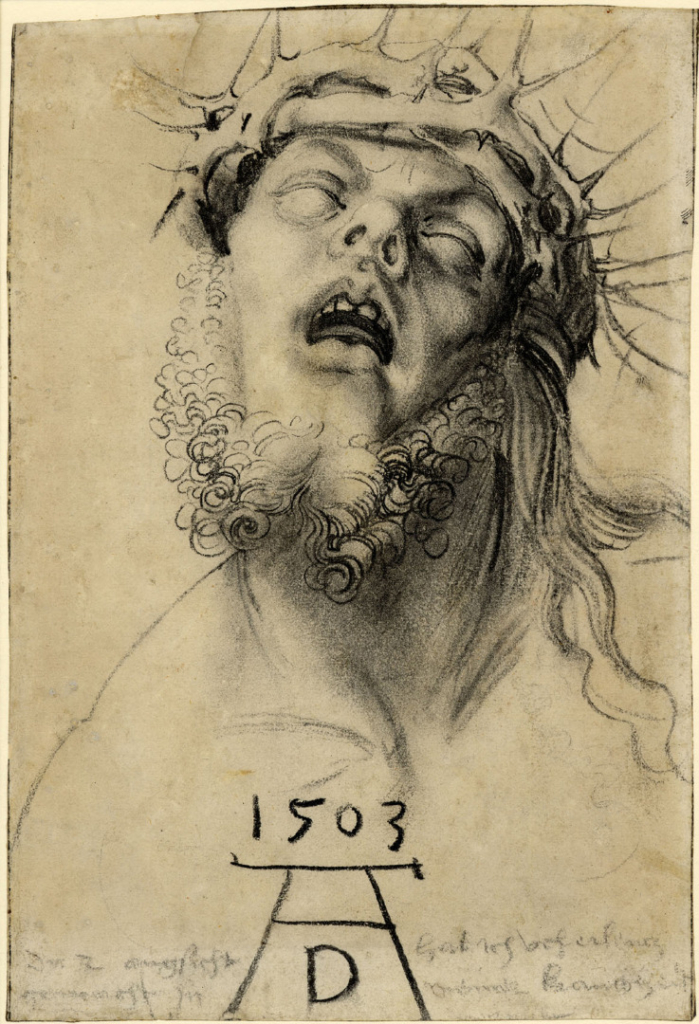
With hollow sunken eyes, furrowed brows and slack-jawed mouths, the dead Christ and the suffering man share an almost identical response to corporeal misery. An inscription just discernible at the bottom of ‘Head of the Dead Christ’ sheds light on Dürer’s motivation for creating the twin-portraits. He noted, ‘These two faces I made in awe [?] during my illness’ (Koerner, 1993, p 220). Created under the cloud of his own pain, these works not only crystallised the philopassianist doctrine that conflated the trials of Christ and the everyday man, they show that Dürer viewed his own disease through this lens.[29] Finally, ‘Self-Portrait, Sick’ (c.1512–1513) demonstrates Dürer’s later interest in employing a Christocentric figure to offer a ‘clinical’ perspective on his experience of illness.
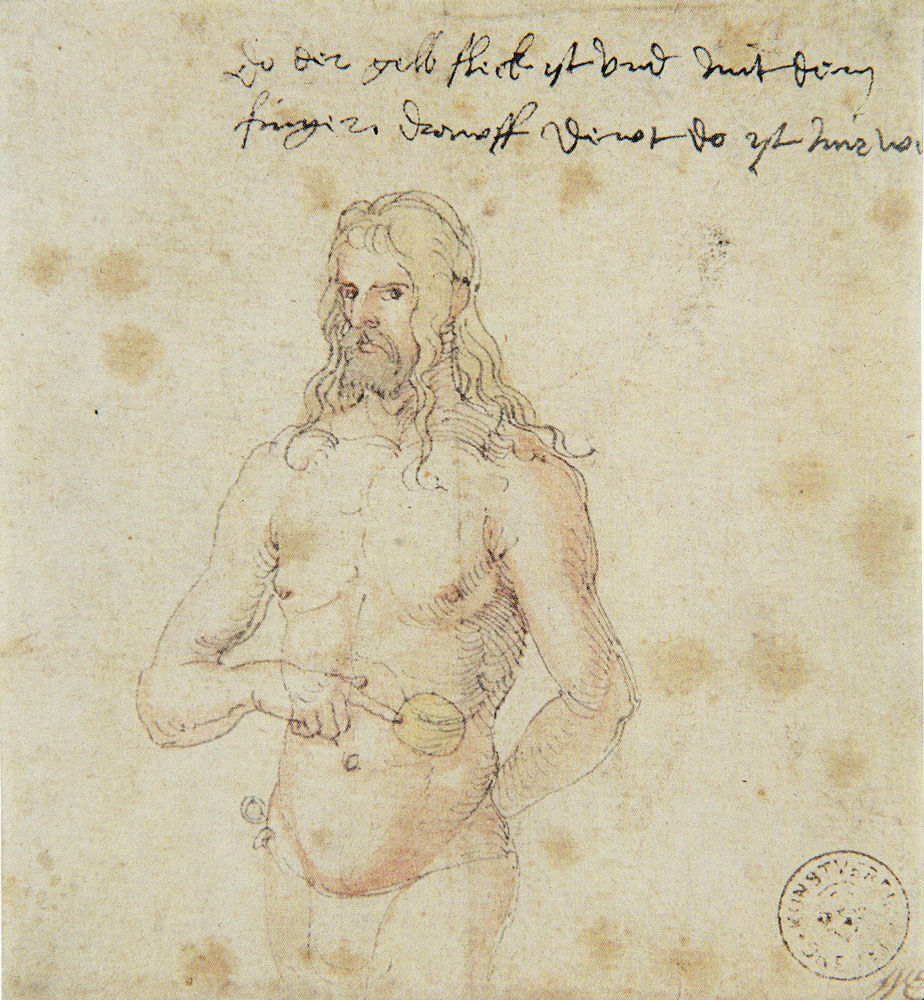
He created this drawing to communicate a source of pain to an out-of-town doctor. Pictured as a three-quarter length figure wearing a loin cloth, with long flowing hair and gesturing in imitation of the ostentatio vulnerum, Dürer looks remarkably like a Man of Sorrows. Staring directly towards the viewer, Dürer points to his abdomen, indicating the area described by the accompanying words: ‘There where the yellow spot is and the finger points, there it hurts me’ (Koerner, 1993, p 177; Schott, 2004, p 1492). Multiple indicators communicate the site of his pain, including the inscription, the naturalistic surface anatomy, the finger that points directly to the pain’s location, and the circle that encloses its perimeter (Koerner, 1993, p 177). Considering these parts together, Koerner assesses the effect of Dürer’s drawing as follows:
In these multiple signs, we sense not so much the efficacy of the deictic in Dürer’s art as its inadequacy for articulating what ails him. For the hurt itself, that experience toward which all representations refer, remains quintessentially accessible only to the body in pain (1993, p 177).
Indeed, it is the difficulty of articulating one’s own experience of pain – particularly pain that is endured in shame or isolation (Hayum, 1977, p 506) – that made the Man of Sorrows such a potent metaphor for the corporeal suffering of everyday people.
Dürer’s ‘Syphilitic Man’ represents a watershed moment in the history of German Syphilisblätter production. To create the first European image of the Great Pox, Dürer combined familiar secular motifs – a celestial globe, a mercenary solider and heraldic symbols – to distil complex relationships of astrological cause and bodily effect into a cohesive illustration. Yet, it is incorrect to think of his ostensibly scientific image as devoid of religious associations. By depicting the solider in a pose mimicking an open-palmed ostentatio vulnerum – as seen in paintings by Giambono, Vivarini and the anonymous artist who worked at Lodi – Dürer elided the image of a syphilitic with the Man of Sorrows, drawing the holy wounds and the lesions of the Great Pox into close association. Furthermore, through his resemblance to open-eyed and active Man of Sorrows images, such as the ‘Michil’ print, the syphilitic is depicted locked in an atemporal state of living death and perpetual suffering that typifies chronic disease. Pictured thus, Dürer’s print and his other Christomorphic portraits accord with philopassianist doctrine that valorised human suffering by viewing it through a Christological lens. ‘Syphilitic Man’ can therefore be seen to advocate for syphilitics like Tommaso di Silvestro as emblems of Christ’s suffering, practitioners of imitatio Christi and worthy recipients of Christian pity, just as lepers had been perceived in earlier centuries.
Penetrating the gash in Late Medieval prayer books
https://dx.doi.org/10.15180/211503/004Sophie Sexon
The two essays preceding have noted how prolific wound imagery was in northern European visual culture, showing the plurality of ways in which wound imagery could appear in both secular and sacred contexts. Lucy Freeman Sandler notes that images of Christ’s wounds abstracted from Christ’s body start to appear after 1320, and that contemplation of the isolated wounds was characteristic of the fourteenth century wherein narrative images were replaced by devotional ones to create greater emotional impact (Sandler, p 86; see Figures 23 and 24). This essay looks specifically at two Late Medieval prayer books from northern Europe made for female patrons: Bonne of Luxembourg’s prayer book (New York, Cloisters Collection MS 69.86) and the Loftie Hours (Baltimore, MS Walters W.165). I will examine how the images of Christ’s abstracted wounds in these prayer books resemble images of vulvas from a wider Medieval visual context and discuss how this may have affected the female viewer’s understanding of Christ’s body. The vulva-wound implored a variety of tactile responses from devotees, and this essay examines to what extent touch conditions certain responses that display a range of effects both sacred and secular in nature, opening up possibilities for exploring differently gendered interpretations of Christ’s wound.
It is important to consider the multivalent meaning of imagery created by women and for women in Late Medieval devotional contexts. Jeffrey Hamburger argues that women were among the primary audiences for devotional imagery in Europe, and that ‘the meanings of these images were as much defined by affective response as by their aesthetic qualities’ (Hamburger, 1997, p 9). The particular affective response I wish to consider here is the role of touch in female devotions, and how this affectively enhances an understanding of both one’s own body and the body of Christ. As women were increasingly involved with lay piety in the Late Medieval period, Christ’s image changed to permit more gender fluidity. This meant that women could increasingly see images of Christ that reflected parts of themselves; both metaphorically and morphologically. An understanding of the shared pains of childbirth and menstruation as Christ’s pains could be considered another form of the philopassianism outlined in Poore’s essay. The image of Christ’s vulva-wound also speaks to Pollick’s conception of Christ’s flowering heart and the wounds as wells; as images capable of depicting Christ’s beauty and fertility.
The complexity of such an image is reflected in the centrality given to abstracted wound-imagery in the Passion cycles of two Late Medieval prayer books. One such example can be seen in Bonne of Luxembourg’s Book of Hours (before 1349)[30], with grisaille miniatures attributed to Jean le Noir and his daughter and collaborator, Bourgot.[31] This small prayer book, measuring 13.2 x 9.7 x 4.2 cm (closed), was made for the Bohemian Princess Bonne of Luxembourg. Folio 331r displays a central image of Christ’s isolated, vertically-orientated side wound.
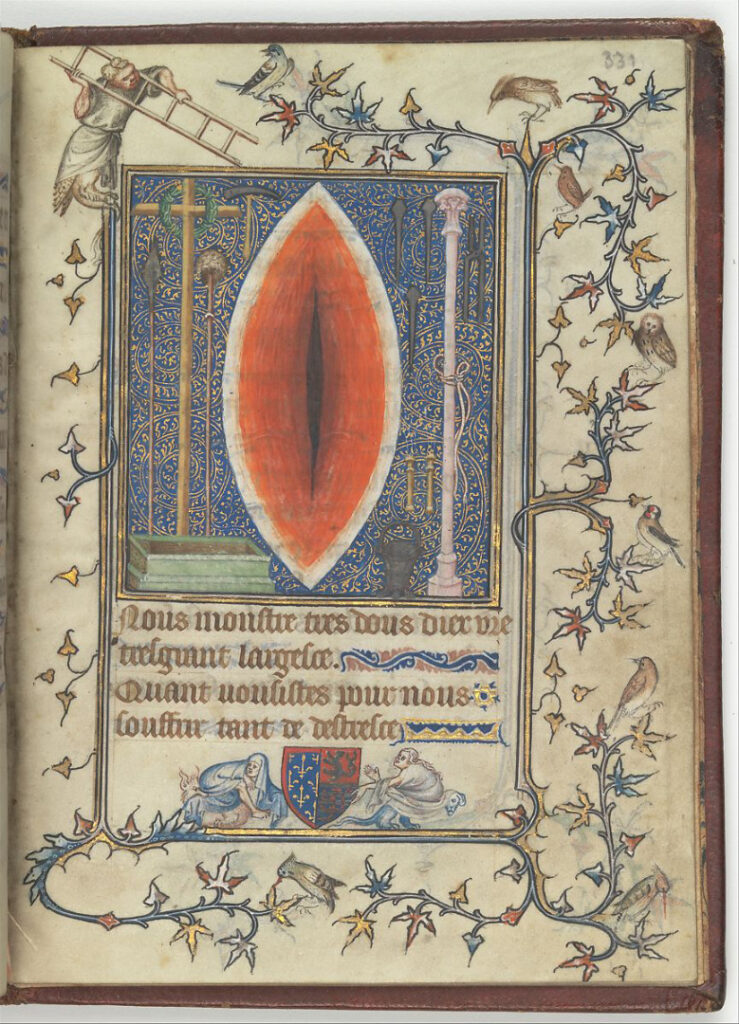
Another example of wound imagery can be found in the Loftie Hours (see Figure 24); a mid-fifteenth century book of hours written in Dutch, containing grisaille miniatures that have been identified with a group of artists called the Masters of the Delft Grisailles.[32]
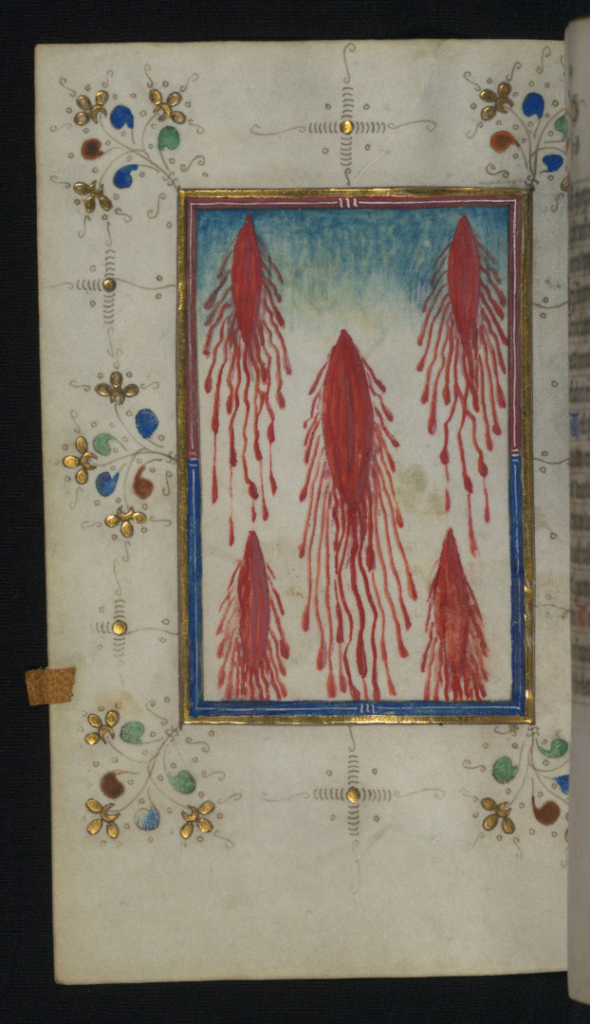
The Loftie Hours, like Bonne of Luxembourg’s prayer book, is relatively small, the pages measuring 9.5cm wide by 14.5cm high. It was intended to be used for personal, private contemplation by a woman identified by the ownership inscription as Margriete Rogm[arie] who was resident in Brussels.[33] The small size of the manuscripts indicate the intensely personal relationship that the reader was encouraged to have with the object, as it would require close contact in order to make out the details of the illuminations. They were also small enough to be portable, and the Loftie Hours bears the spectral impressions of two pilgrim badges which have been removed on folio 112v. Both small prayer books were created for female owners in order for them to be used as part of personal and intensive affective meditations on Christ’s body and humanity. These manuscripts and others demonstrate an expressly haptic response to the image of Christ’s body, showing where patrons have kissed or rubbed away the image of Christ’s wounds.[34] The side wound merits considerable pictorial attention in both manuscripts, but unlike Taylor 17, the side wound is not encircled by Christ’s heart but rather abstracted from the body and re-orientated to a horizontal position. Just as Pollick notes of the flowering imagery, extra-textual evidence is not provided in the accompanying prayer as to why the side wound appears in horizontal position, leading the viewer to have to look beyond the manuscript context to ascertain why it would be depicted in such a way.
Many different objects bore images of Christ’s wounds isolated from his body. Amulets and charms depicted images of wounds, which would be used in a variety of ways.[35] Birthing girdles bearing depictions of the side wound were pressed against women in labour to help with birth or menstrual pain (Easton, 2006, p 404). These images were often activated by touch in order to experience their apotropaic benefits. In many cases, one didn’t even need to read the accompanying prayer or rubric to receive the benefits of the image: the power of the image could prevent sickness, death or misfortune if it was looked at or carried by the bearer. Scholars including Martha Easton (2006; 2008) and Karma Lochrie (1997) have previously discussed the vaginal significance of Christ’s wounds in Late Medieval culture, drawing comparisons between images of Christ’s wound that appear in prayer books and images of vulva that appear in sculpture or on pilgrim badges. There are many carvings of Sheela-na-gigs, sculptures of women pulling open their labia, which appear on the exterior of Medieval Romanesque churches in Britain and Ireland. Easton comments on the public visibility of Sheela-na-gigs being at odds with the ‘pattern of expected/accepted iconography’ (Easton, 2008, p 15), yet their appearance demonstrates that image makers weren’t reluctant to place images of vulvas in sacred spaces. Representations of genitalia can also be found on Late Medieval pilgrim badges.[36] Pollick compared the flowering heart imagery to love token badges. Comparison with Medieval pilgrim badges might influence our understanding of manuscript imagery in this instance, too. Jos Koldeweij notes that around 2,000 religious and profane badges have been found in Dutch and Flemish soil, which were ‘mass produced and must have been widely distributed from the early thirteenth century until about 1550’ (Koldeweij, 2005, p 493). Such badges are what have left impressions on folio 112v of the Loftie Hours (although it is hard to tell what images were on the badges from the impressions left in the manuscript).[37] Koldeweij notes that amongst that variety of badges there are ten known variants on the image of ‘the vulva-creature – the female sexual organ incarnate – dressed up as a devout pilgrim, complete with a pilgrim’s hat, staff, and rosary’ (Koldeweij, 2005, p 493). Similar to Figure 10, which depicts a crowned heart on the badge, some vulva badges also depict crowned and anthropomorphised body parts. One badge depicts a crowned vulva, being carried on a litter by three penises that have arms, legs and tails (Koldeweij, 2012, p 207). Just as heart badges feature an externalisation of an internal organ, badges depicting penises and vulvas make usually hidden body parts visible via the artistic medium. Images of vaginas could therefore be seen in both public places and religious spaces. In the cases of genital pilgrim badges and Sheela-na-gig sculptures there is interplay between sacred and secular imagery showing a rather viscous border between what we consider the sacred and profane. I argue that this tension is also evident in the depiction of Christ’s side wound. Examining the role of touch helps us to explore these possibilities and demonstrates incredible versatility of an image that, at first glance, maybe seem like a simple abstraction.
Devotional objects depicting the effusive bleeding of Christ’s body often show us the manner in which they are to be touched, as Hamburger points out in his analysis of nonnenarbeiten (nuns’ works). He refers to an image in which St Bernard and a nun caress Christ’s body that is almost hard to see beneath under ‘the livid profusion of red ink saturating the paper’ (Hamburger, 1997, p 15). Hamburger notes that the image is instructive – that as the creator and viewer of the image would have been a nun herself, she ought to caress Christ’s body like the nun depicted in the scene. In instances where Christ’s body cannot be seen owing to how bloody the image is, touch is considered an adequate affective mode for the enactment of devotion in substitution for sight. One common characteristic of wound imagery is the vivid use of red ink or paint which offers a lifelike approximation to blood, and to the abject quality of femininity. Hamburger discusses how Christ is depicted as both beautiful (flowering and lively) and ugly (dead and abject), vacillating between both extremes. In the case of images showing a profusion of blood, ‘the abject was linked not only to the new and inferior, but also to the feminine, witness the feminization of the suffering Christ’ (Hamburger, 1997, p 23). Vibeke Olson notes that Christ’s bleeding wound would mix with the tears, saliva and sweat of the person touching the image in the manuscript, animating the image with bodily fluids to make the wounds ‘bleed’ and offering a ‘a sensory experience of the absent body’ (Olson, 2015, p 12), creating a more lively and effective image by mixing bodily fluids with paint. Rather than the beautiful, life-giving blood of Pollick’s flowering Christ, Christ’s blood in these manuscripts harbours aspects of pain and abject femininity, asking the votary to consider the abject and untouchable as important contact relics in their particular relationship with Christ.
The images of the five holy wounds in the Loftie Hours form the Passion cycle along with other narrative images that focus on the prominent, streaming nature of the bleeding wounds as contrasted against Christ’s dead body. Folio 79v (see Figure 25) is a Man of Sorrows image showing the display of Christ’s wounds (ostentatio vulnerum) with Christ amidst the arma Christi.
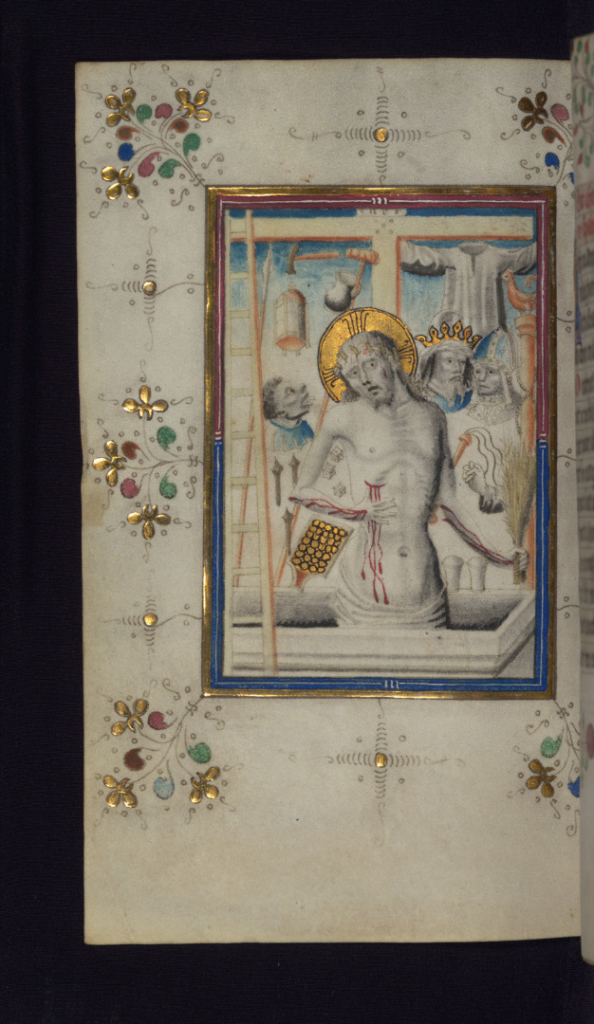
Much like the figure of Dürer pointing at his own wound to draw attention to it (see Figure 22), Christ here displays his horizontal wound and engages with the viewer by looking face on, presenting an uncanny contrast between the dead Christ and the risen. In this image, the blood from Christ’s hand wounds has dried on his arms and here the side wound is depicted as a horizontal wound, with blood trickling down vertically. In the Deposition scene on folio 26v (Figure 26), Christ’s head bears similarity to Dürer’s depiction of the dead Christ (see Figure 21), drawing attention to the lifelessness of Christ’s body in grisaille miniature with contrasting red blood trickling vertically out of horizontal wounds.

In the full-page miniature of the five wounds on folio 110v (see Figure 24), the wounds are abstracted without any surrounding objects depicted in grisaille to bring Christ’s dead body to mind. Here they appear fresh and still bleeding. Like Bonne of Luxembourg’s Hours, the central side wound has changed orientation from horizontal to vertical, increasing the morphological parallels with a vulva. Here we can see the wounds have been touched in some way, as some of the paint has worn from the lower two wounds. In these manuscripts the ostentatio vulnerum trope not only displays the side wound but encourages the viewer to think about the role of sight and touch in their affective devotions. Christ touches his wound in Figure 25 and Figure 27. In the image on folio 328r of Bonne of Luxembourg’s Hours (Figure 27) Christ brings focus to his side wound by pointing at it, and his exaggerated, elongated finger touches it, possibly prompting the patrons of the image, Bonne and her husband pictured praying below, to engage with his wound in the same manner.
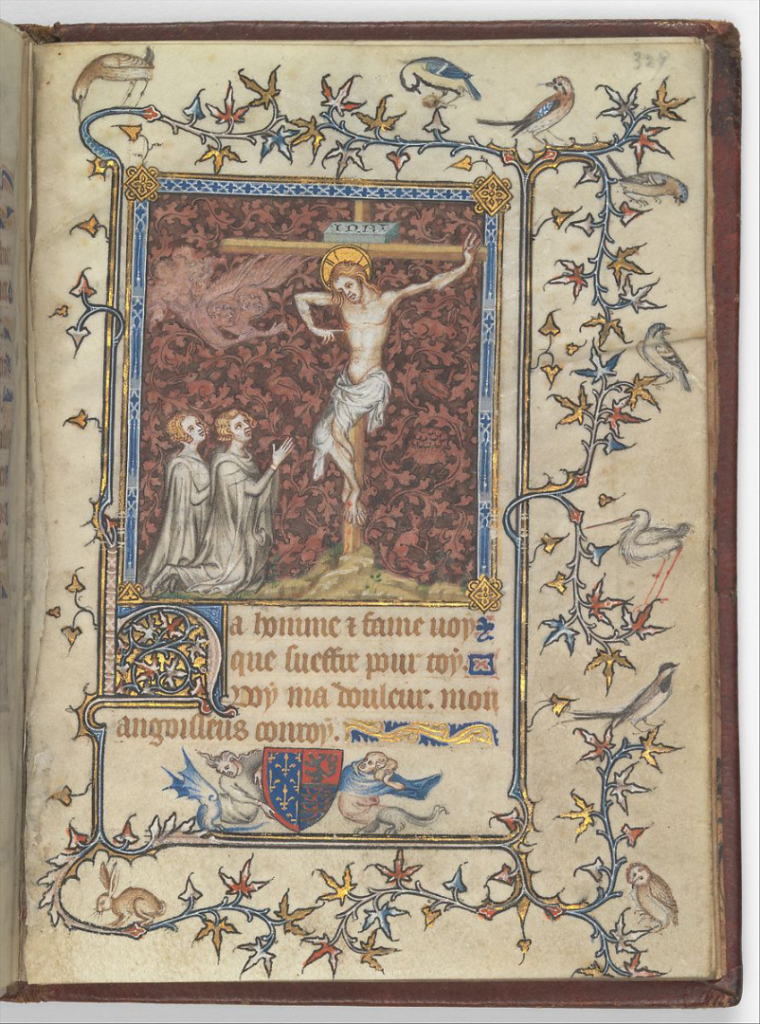
On folio 328r of Bonne’s prayer book the function of the image is not only a display of the wounds (ostentatio vulnerum) but also a tactile directive to look closer at the wound, which is the next image displayed in the Passion cycle, represented on folio 331r, where we assume the viewpoint of Christ’s pointing finger from folio 328r. Somewhere between these images, the wound is re-oriented, as it is depicted horizontally on folio 328r yet is vertically depicted on folio 331r (see Figure 23). This side wound becomes, as Richard Rambuss notes, an ostentatio genitalium, capable of signifying eroticism through the affective response it prompts (Rambuss, 1998, p 44).
Pollick notes that ‘The Carthusian Miscellany’ visually engages with the idea of wounding words by depicting a monk’s heart pierced with a scroll that reads ‘Jesus is my love’ (see Figure 7). This is a fantastic visual depiction of how prayers ‘wound’, as we see that the amorous words pierce directly through the heart. However, words are not the only things intended to penetrate and wound the sacred heart. David Areford describes how speerbilder (woodcut prints) were created in the mid-fifteenth century depicting the wound in Christ’s heart, engaging with the idea of a very literal wounding through the page. The images were expressly designed to be cut by the Holy Lance as part of an annual display of imperial relics in Nuremberg’s marketplace. The bloodied wound appears to be both metaphorically and literally bleeding; visually depicted as such on one side, and displaying the red pigment that has been poked through the slit in the paper on the other side. This encourages the person looking at it to consider both sides of the object and to penetrate the gash themselves with their fingers to gain better affective contact with Christ. Areford argues that the slit through the paper and the ‘messy red puddle’ on the back of the image ‘were clearly integral to its meaning and authenticity’ (Areford, 2012, p 82). Penetration is a vital part of devotion. In one of the nonnenarbeiten that Hamburger describes, there is an image of a nun exchanging vows with Christ in the centre of a heart, which in turn signifies the nun’s own heart and Christ’s heart. Hamburger writes, ‘we zoom in on the stunning, even shocking, image of the heart at the center, penetrating the gash to find ourselves – in the person of the nun identified by her habit – nestled within the womblike space at the center, exchanging vows with Christ…it compels us, and more specifically, the female viewer to whom it was originally addressed, to perform the act of penetration that in the Song of Songs 4:9 prompts the bridegroom to respond “thou hast wounded my heart, my sister, my spouse…”’ (Hamburger, 1997, p 26). The penetrating wounding act can be enacted by the female devotee, here exercised upon the feminised mystical bride Christ. In complicated wound imagery, the wounded heart we see is both Christ’s and the nuns, drawing comparisons between the two bodies as being internally similar. The penetrating role of both vision and touch is by no means only active for male devotees, as we see here evidence of an active female engagement with these objects depicting Christ’s wound.
The manuscripts can also be wounded by the haptic engagements of their female owners. In a variety of manuscripts the wounds on Christ’s body have been kissed and touched so vigorously that they have been worn away. In the Loftie Hours, this has resulted in the abrasion of the pigment in the lower two wounds on folio 110v (see Figure 24). In an analysis of Dutch manuscripts that contain prayers to Christ’s five principal wounds, Rudy notes that certain prayers ‘demand’ that votaries interact with images, not only performing that prayer in front of an image, but also physically interacting with the image. In the case of the Colnish Pater Noster, the prayer was divided into fragments that were mapped onto Christ’s wounds. One was supposed to speak the prayer into the wounds, so that ‘the prayer and its accompanying performance involve visually scrutinizing, handling, and even tasting the Saviour’ (Rudy, 2012, p 464). This act gives promise of various indulgences (such as protection from pain and sudden death). In the rubric of the prayer it is written that ‘the more one shoots this prayer with love and devotion into the wounds of our dear beloved Lord Jesus Christ, the sooner one received more gifts from doing so. And although this prayer may seem distasteful at first, the longer one practices it, the tastier it becomes to him’ (Rudy, 2012, p 466, quoting from The Hague, KB 131 H 4, fols. 48v-55r). It is clear that prayer and image are brought together through sensory experience to enhance affective practice, where it is expected that lips and fingers will wound the manuscript image to gain better spiritual contact with Christ.
The orientation of the viewer in relation to the wound image may have gendered implications. Rudy notes how the prayer to the five wounds humbles the speaker by positioning them at Christ’s feet (Rudy, 2012, p 464). In the Franciscan tradition, the Pater Noster would be said into each wound, beginning at Christ’s left foot wound and working upwards. Rudy writes that when the votary recited a gloss on the prayer to the ‘father’ at the foot, she submits to a ritual and ‘undergoes a transformation, casting herself in the position of Jesus praying to his heavenly father at the garden of Gethsemane awaiting his Passion. The text of the prayer emphasizes the smallness of the petitioner, a lowly, withered, and wounded creature awestruck in the face of God. By referring to herself in the terminology of abasement, the petitioner further conjoins her identity with that of Jesus, both the Jesus in the Garden who is sick, nervous, and sweating blood, and the Jesus on the cross who is suffering a slow death along with excruciating, fatal wounds’ (Rudy, 2012, p 465). The act of saying the prayer starting from a lowly position at the base of Christ’s feet both establishes the votaries’ lowly relation to Christ and positions her as Christ, a ‘lowly, withered, and wounded creature’ in multiple senses. However, this feminine position of lowliness is not stable across all wound imagery, as one can see from the viewer orientation of vulva-wound imagery that one can ascend spiritually and attain a position of equality with Christ, while reflecting on one’s own vulva.
In depictions of the Crucifixion, worshippers traditionally appear at the bottom of the image looking up at Christ, such as Bonne and her husband do (see Figure 27) and the male monk in ‘The Carthusian Miscellany’ who consistently appears at Christ’s feet (see Figures 7 and 8). Yet in both Bonne’s prayer book and the Loftie Hours we view the images of the abstracted wounds as though we are placed directly in front of them, not from below. During the course of the prayer to the five wounds in the Loftie Hours the worshipper changes orientation: working her way up from Christ’s feet to the higher wounds during the course of the prayer, and the ascendance the wound imagery offers can show a spiritual transcendence of the confines of gender. In Bonne of Luxembourg’s psalter we see images of a woman ascending the Throne of Charity in 315r, accompanied by a text interlude that describes the six steps, representing the six degrees of charity, that ‘on monte ordeneement pour venir a parfait amour de dieu’ (we go up orderly to come to a perfect love of God). Hamburger notes that in the nonnenarbeiten of St Walburg the nun depicted has ascended the ladder (which is often depicted as part of the arma Christi) and is nestled inside the wound, positioned as Christ’s mystical bride (Hamburger, 1997, p 27). The female creator therefore uses the symbolic imagery of the arma Christi to elevate herself, effectively ‘climbing the ladder’ as part of the narrative of the image to demonstrate an equality with Christ. In Bonne of Luxembourg’s prayer book (see Figure 23) a ladder appears in the space external to the central wound image, not from below the image, but from above, held by a grotesque hybrid creature: partly human, partly animal. The female viewer of this image is not positioned at the bottom looking up at the wound, but rather shares the liminal space of the grotesque; looking down at the image of the vulva-wound and her prayer book. The ladder seems to be part of the arma Christi and a didactic visual aid telling us where and how to look. Placing the female patron of the prayer book in the same space as the grotesque links her viewing position with abjection (being cast out of both the sacred and social space). However, looking down at the wound places the viewer in a similar position to Christ on the cross as he would only be able to view the side wound by looking down his own body. The female devotee is a hybrid herself; part Christ, part grotesque; part male, part female. As Christ crucified, she is looking down at her side wound. But by exhorting her to look down at the image of the wound in the prayer book, possibly placed in her lap, the directive suggests that the image of the side wound is similar to the vulva of the female viewer holding the book. The female viewer is encouraged to direct their gaze downward on the manuscript and their own body to find their own vertically orientated slit; connecting to Christ’s wound by finding morphological parallels on their own body. Just as the heart in Taylor 17 prompts the viewer to consider their own heart, the vulva-wound entreats the viewer to consider their own vulva, and in doing so, gain greater understanding of how their own body relates, through affective practices, to Christ’s body as depicted in the manuscript in their own hands.





